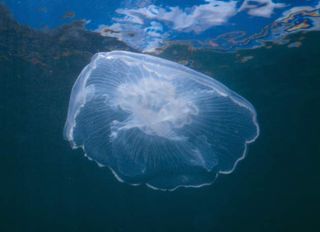Jellyfish Invade the Globe, Thanks to Humans

There are exotic Frankenfish in the Potomac, unbearably noisy foreign frogs in Hawaii, and the destructive spiny water fleas that have snuck into northern lakes.
Now you can add alien moon jellyfish to the growing list of invasive species that threaten ecosystems around the planet.
Scientists announced the discovery of 16 new species of "moon jellyfish" today while also saying the creatures are invading marine environments all over the world.
We're to blame
The jellyfish are carried by ships, the researchers said. They join several other species that have hitchhiked into new habitats, often to the demise of native species.
The moon jellyfish could not have migrated naturally to so many corners of the globe, the scientists report.
The researchers conducted a 7,000-year computer simulation of possible movement based on ocean currents and the creatures' less-than-Olympic swimming skills. That combined with genetic data leaves ships as the only logical mode of transportation.
Sign up for the Live Science daily newsletter now
Get the world’s most fascinating discoveries delivered straight to your inbox.
Ships take in water for stability, and some ends up in faraway harbors.
"Marine organisms traverse the globe in ballast water, on ship hulls and through the trade of exotic species such as tropical fish," said study leader Mike Dawson of the University of California, Davis. "This has potential to displace local marine species, threaten ecosystems and cause billions of dollars in damage and preventive control."
Growing problem
Other studies suggest that nearly a quarter of all marine species in international harbors are alien, Davis said.
He has tracked the invading jellyfish in Japan, California, western Europe and Australia. The moon jellyfish are, in fact, just about everywhere, including Mexico, Alaska and along the Atlantic Coast of the United States. They include the stinging Portuguese man-of-war.
But 500 years ago, the study finds, they were not so widespread.
"Until now our knowledge of natural and human-assisted dispersal of species has been insufficient to confidently track and predict the spread of non-indigenous marine species," said University of New South Wales researcher Matthew England, who helped develop the computer program. "Now we have a tool that can include data on currents, geography and the biology of an organism to help separate natural dispersal from that which happens through shipping.
The DNA study also revealed that there are more species of moon jellyfish than known.
"We identified 16 species of moon jellyfish, revealing that marine biodiversity is actually much higher than was thought previously,"Dawson said.
The work was detailed today in the Proceedings of the National Academy of Science.
- Ugliest Animal: You Decide!
- Invasive Creatures Attack Like Internet Viruses
- Mystery of Large Squid Caught on Video
- More 'Frankenfish' Found in Potomac
- Hawaii Fights Noisy Frog Invasion
Image Gallery

Invasive Species
Robert is an independent health and science journalist and writer based in Phoenix, Arizona. He is a former editor-in-chief of Live Science with over 20 years of experience as a reporter and editor. He has worked on websites such as Space.com and Tom's Guide, and is a contributor on Medium, covering how we age and how to optimize the mind and body through time. He has a journalism degree from Humboldt State University in California.

